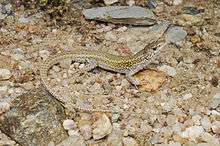Podarcis carbonelli
Podarcis carbonelli, commonly known as Carbonell's wall lizard, is a species of lizards in the family Lacertidae. It is endemic to Portugal and Spain.
| Podarcis carbonelli | |
|---|---|
 | |
| Scientific classification | |
| Kingdom: | Animalia |
| Phylum: | Chordata |
| Class: | Reptilia |
| Order: | Squamata |
| Family: | Lacertidae |
| Genus: | Podarcis |
| Species: | P. carbonelli |
| Binomial name | |
| Podarcis carbonelli Pérez-Mellado, 1981 | |
| Synonyms[2] | |
| |
This lizard reaches a total length (including tail) of 20 cm (8 in), and feeds primarily on small invertebrates such as insects, arachnids, and snails.[3] Its natural habitats are temperate forests and sandy shores. Habitat loss threatens its survival.
Etymology
The specific name, carbonelli, is in honor of "J. Carbonell" who is the wife of Pérez-Mellado.[4]
Description
Carbonell's wall lizard grows to a snout-to-vent length of 6.5 cm (2.6 in) with a tail about twice as long. Females tend to be slightly larger than males in some localities. The dorsal surface is usually grey or brown, but is sometimes green (especially so in males), copiously speckled with rows of dark markings. The flanks may also be somewhat greenish with reticulated, dark markings. The underparts are whitish and there are often small blue spots along the edge of the belly. Carbonell's wall lizard much resembles the closely related Bocage's wall lizard, but that species tends to have more clearly defined markings and a yellow, orange or pink belly, and lacks the blue spots.[5]
Distribution and habitat
Carbonell's wall lizard is endemic to Portugal and Spain. Its range consists of a number of isolated populations in western and central Portugal, another in Coto Doñana in southwestern Spain and a separate subspecies is present on the Berlenga Islands off the coast of Portugal. Some of the populations are in hills at altitudes of over 500 m (1,640 ft), where the lizard occurs in oak woodland and scrub, and others are in sand dunes near the coast.[1]
Behaviour
Carbonell's wall lizard is often seen on dry banks where it may be present in large numbers. It takes refuge in cracks and among tree roots. It feeds mainly on arthropods but, particularly on the Berlenga Islands, also consumes snails. In central Portugal there is usually one clutch of two eggs each year, but in the Berlengas, several clutches of up to four eggs are laid. These take ten to fifteen weeks to hatch.[5]
Status
Carbonell's wall lizard has a number of isolated populations and its total geographic range is less than 5,000 square kilometres (1,900 sq mi). It lives in oak woodland and although some populations are in protected areas, others are subject to habitat degradation. Although it is common in some suitable habitats, in general the population is thought to be declining and the International Union for Conservation of Nature has assessed it as being an "endangered species".[1]
References
- Sá-Sousa, Paulo; Pérez-Mellado, Valentin; Martínez-Solano, Iñigo (2009). "Podarcis carbonelli". IUCN Red List of Threatened Species. 2009: e.T61545A12512496. doi:10.2305/IUCN.UK.2009.RLTS.T61545A12512496.en.
- "Podarcis carbonelli ". The Reptile Database. www.reptile-database.org.
- Lagartija de Carbonell. p. 164. Archived 2009-12-19 at the Wayback Machine
- Beolens, Bo; Watkins, Michael; Grayson, Michael (2011). The Eponym Dictionary of Reptiles. Baltimore: Johns Hopkins University Press. xiii + 296 pp. ISBN 978-1-4214-0135-5. (Podarcis carbonelli, p. 47).
- Arnold, E. Nicholas; Ovenden, Denys W. (2002). Field Guide: Reptiles & Amphibians of Britain & Europe. Collins & Co. p. 153. ISBN 9780002199643.
Further reading
- Pérez-Mellado, Valentin (1981). "Nuevos datos sobre la sistemática y distribucion de Podarcis bocagei (Seoane, 1884) (Sauria, Lacertidae) en la Península Ibérica ". Amphibia-Reptilia 2: 259-265. (Podarcis bocagei carbonelli, new subspecies). (in Spanish).
- Sá-Sousa, Paulo; Harris, D. James (2002). "Podarcis carbonelli Pérez-Mellado, 1981 is a distinct species". Amphibia-Reptilia 23 (4): 459-468.
